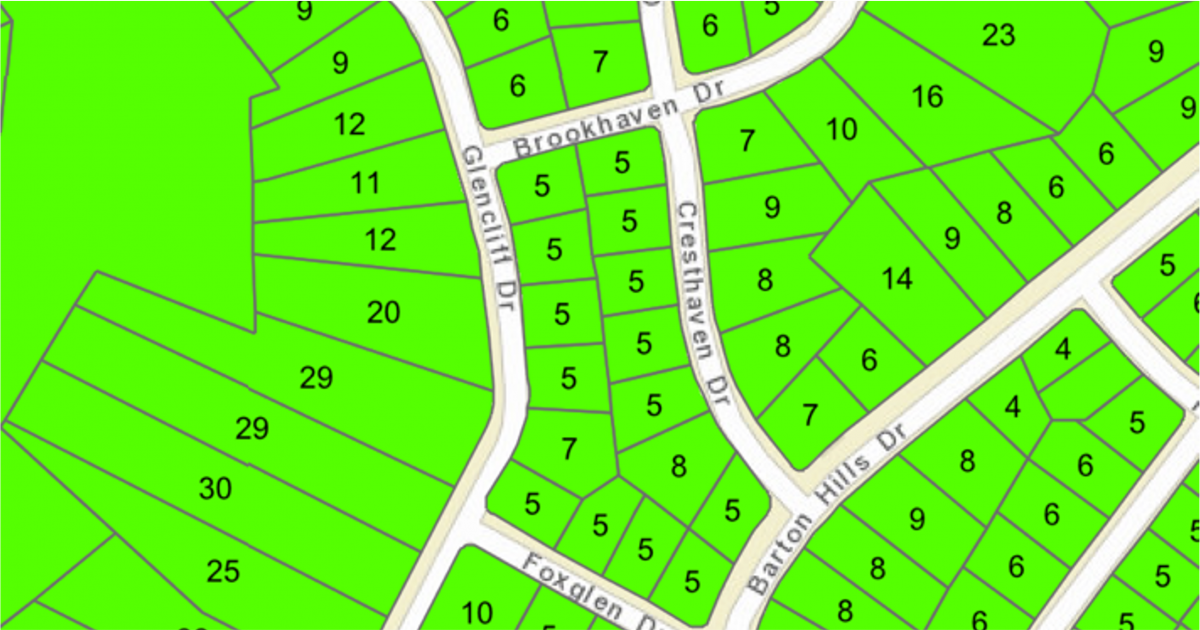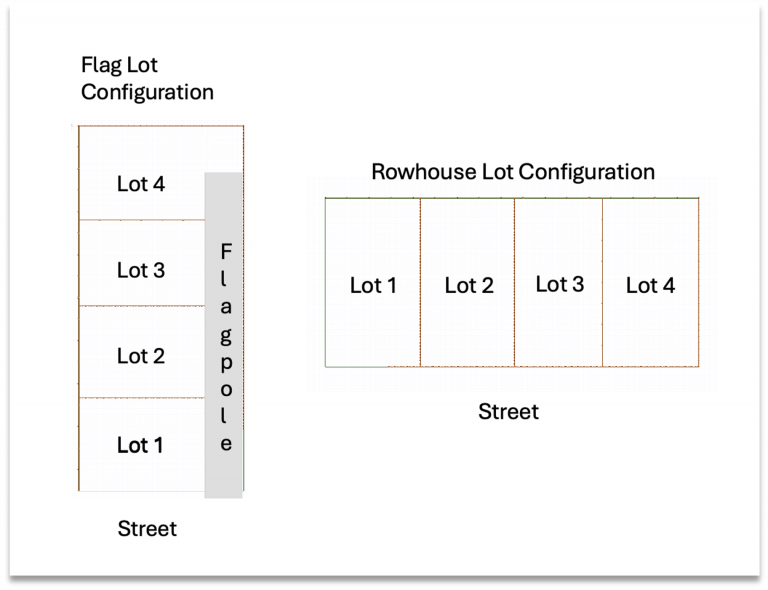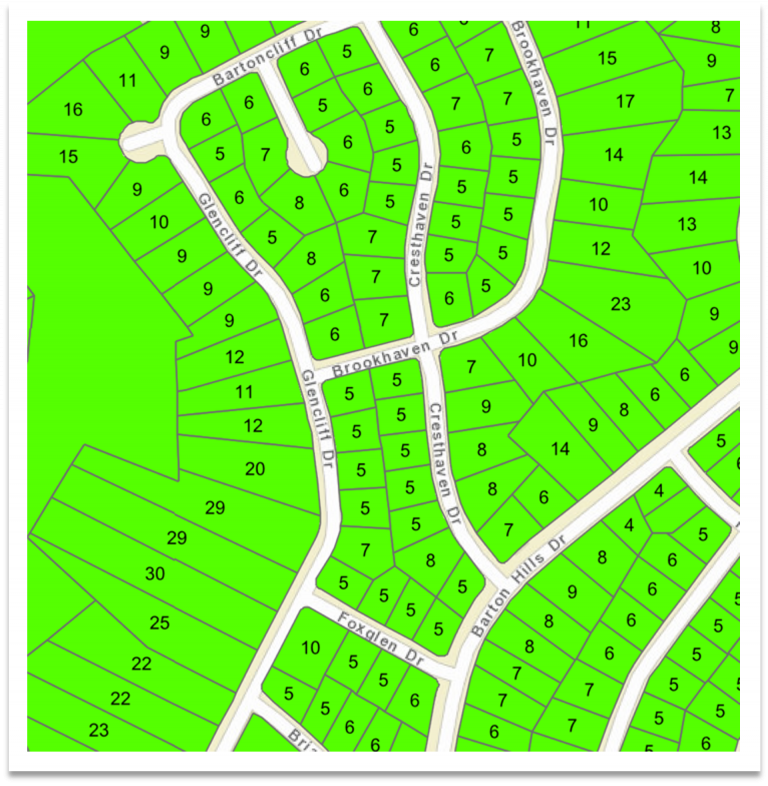Necessary Background: Land Code Changes Passed in 2023 (H.O.M.E.NEXT Phase 1)
Mayor Kirk Watson and the city council split their H.O.M.E.NEXT neighborhood rezoning for redevelopment resolution into two phases. They passed Phase 1 on December 7, with Alison Alter and Mackenzie Kelly voting against it. Here is what it did:
- More dwelling units on single-family lots
- Structures closer to the street
- More cars on your street
- More short-term rentals (STRs)
- Bigger buildings from removal of “McMansion” protections
- No more local occupancy limits
Read this blog post for more details on the above Phase 1 changes.
Coming Up: H.O.M.E.NEXT Phase 2
The city sent postcards for delivery around April 1, announcing changes to the Land Development Code and setting public hearings. The city council meeting to vote on this ordinance is scheduled for May 16 at 10:00 AM.
Here are among the most impactful changes in the proposed Phase 2 ordinance:
Reduction in Minimum Lot Sizes
Phase 2 establishes smaller minimum lot sizes of 2,000 square feet for all SF-1, SF-2, and SF-3 properties without an additional zoning change. SF-1 lots are currently 10,000-square-foot minimum, and SF-2 and SF-3 lots are 5,750-square-foot minimum. A property owner would only have to file a re-subdivision of an existing lot. Staff also recommends simplifying the infill re-subdivision regulations to expedite development reviews.
These smaller lots expand Phase 1 by permitting a single larger lot to be subdivided into separate 2,000 square-foot lots, each with one unit. That subdivision is facilitated by reducing the minimum lot width to 20 feet, reducing setbacks between structures, reducing front and rear setbacks to 15 feet and 5 feet, respectively, and using “flag lots,” which locate one or more lots (the “flag”) behind the front lot with the rear lot(s) accessible by a driveway (the “pole”). The examples below show an existing 8,000-square-foot lot divided into four lots depending on its street frontage:
The City of Austin’s staff presentation at the April 11 joint meeting showed these examples of their vision for existing neighborhoods (a current 6,000 square-foot lot could be divided into three lots):
The maximum impervious cover in the front yard is limited to 50% (except for flag lots). Building cover limits are removed, but impervious cover is currently capped at 45% (an increase of 5% for SF-1). However, the council’s Housing and Planning Committee says the planned ordinance will “adjust setbacks, height, and impervious cover for single-family zoning to allow more units on smaller lots.” HINT: Watch for amendments.
The following map shows the SF-1, SF-2, or SF-3 (darker to lighter green) properties subject to “H.O.M.E.” Phase 2. An interactive version of this map can be seen here. You can use the magnifying symbol to look up addresses.
When you zoom in, you can see how many 2,000-square-foot lots can be created by dividing an existing lot:
Questions Raised by the Re-subdivision of Existing Lots
- How will my property taxes be affected? Taxes will increase on the land because land gets taxed based on entitlements. In Mueller, small-lot land taxes range from $183 to $275 per square foot. Standard residential lots northwest (by the Arboretum) are valued at $27 per square foot, while closer to downtown (south of the river), they are at $42 per square foot. Montopolis is $17 per square foot. Mueller’s small lots are appraised at 1,620% of a standard lot in Montopolis per square foot.
- Does existing infrastructure and water support this 300%+ increase in density?
- Are there adequate public safety facilities, such as fire, police, and EMS stations, to support the increase?
- With more paving allowed in front yards and more density, how will inadequate stormwater infrastructure handle rain events?
- How many trees will be lost to decreased setbacks?
Displacement of Residents
Speculation and redevelopment will cause the displacement of lower- and middle-income renters and homeowners, as seen in Houston after small lots were allowed:
Intensive demolition patterns combined with the proportion of townhomes in newly built units (which attract higher-income households) foreshadow continued sociodemographic shifts … [that] contribute to the displacement of long-term residents on fixed incomes …
In Austin, after East Side neighborhood plans encouraged and allowed smaller lots and more development, much of the minority population was displaced.
Even the city’s own COA Affordability Impact Statement acknowledged as much:
This massive inflation in prices is not a function of zoning and its impact to development cost; Rather, it is the product of land speculation and the right to treat housing as an investment.
Market driven solutions to the housing crisis will likely reproduce the same dynamics that play out today, wherein parties with more resources may take advantage of the new regulatory landscape, while those with the fewest resources experience an increase in precarity.
Those conclusions were backed up by a report done by UT-Austin’s Rich Heyman for the city titled “The Flawed Logic and Lack of Evidence Behind Austin’s HOME Initiative.”
From the report:
- The HOME Initiative is based on faulty assumptions that rely on deeply flawed research which itself is not supported by evidence, as well as on research that is not applicable to the Austin context.
- The increase in land and housing prices in Austin in recent years are the results of fundamental dynamics of urban land markets, long known in the literature, and not due to zoning or other “constraints” on supply. They are the outcomes of market processes, not a distortion of them.
- The HOME Initiative is unlikely to achieve its goals of increasing affordability in Austin and will likely lead to higher property values throughout the city, as well as continued gentrification and displacement in lower-income neighborhoods, home to many of Austin’s residents of color.
Read Dr. Heyman’s guest opinion in The Austin Chronicle here.
Research does suggest that deregulation of land use/zoning is likely to increase land values in general and to impact neighborhoods vulnerable to gentrification the most. HOME is unlikely to increase affordability for most Austinites.





